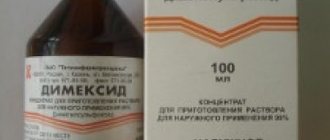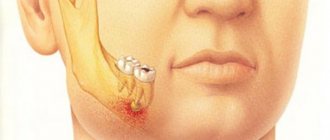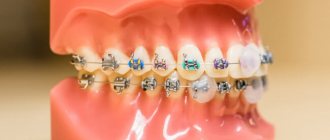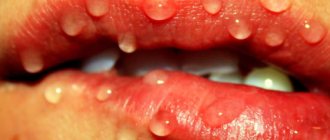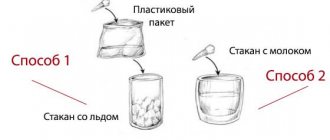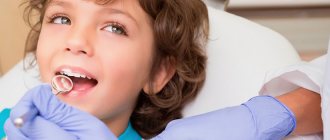Children's lymphadenitis: causes
In most cases, an enlarged lymph node is considered a normal reaction of a healthy body to an infection. The inflammatory process can occur for a number of reasons. Any infection or virus, including the common cold, can cause swollen lymph nodes. Often the cause of swelling is blood cancer, leukemia, lymphoma.
From a physiological point of view, lymphadenitis is provoked by the following pathological processes occurring in the body:
- abnormally rapid division of cells (lymphocytes, monocytes, histiocytes) inside the node;
- infiltration of cancer cells from outside the node (also known as metastasis);
- infection;
- damage to the body by streptococcal bacteria;
- mononucleosis caused by the Epstein-Barr virus.
Also, lymphadenitis often occurs against the background of tuberculosis and AIDS. Chronic inflammation of the lymph nodes for no apparent reason may be an early symptom of lymphoma, leukemia, or the rare Kawasaki disease. In any case, changes in the child’s health should not be ignored. Enlarged and inflamed lymph nodes (provided there are no other symptoms of infection) should be a reason to consult a pediatrician.
Lymphadenitis in children, what else should you think about?
Types and symptoms of the disease
Lymphadenitis was assigned a code according to ICD 10: L04. However, the international classifier generally reflects only the acute form of the disease. In fact, there are many types of lymphadenitis. The classification used by pediatricians is multilevel.
Regional and generalized lymphadenitis
The most common form of the disease: localized (regional) lymphadenitis. In this case, one or more nodes located around the affected part of the body become inflamed. For example, the cause of lymphadenitis in the neck may be inflammation of the tonsils.
Generalized lymphadenitis is diagnosed if three different groups of lymph nodes (or more) have been affected. The development of the disease is usually triggered by an infection that spreads through the bloodstream.
Acute, subacute and chronic lymphadenitis
Chronic lymphadenitis is diagnosed if the inflammation recurs several times within a limited amount of time. The chronic form of the disease most often occurs in children under 12 years of age.
Factors that increase the risk of chronic inflammation of the lymph nodes:
- close contact with a person suffering from chronic infections;
- non-compliance with clinical recommendations in the treatment of acute forms of the disease;
- “under-treatment” of infectious diseases (stopping taking antibiotics immediately after symptoms disappear).
Acute lymphadenitis is conventionally divided into unilateral and bilateral. The bilateral type of disease is provoked by a viral infection of the upper respiratory tract or bacterial pharyngitis. Less commonly, the disease is a manifestation of a systemic infection.
Acute unilateral lymphadenitis in 80% of cases is caused by the organisms S. pyogenes and S. aureus. The disease is most often diagnosed in newborns. In older children, the nodes become inflamed on only one side due to dental diseases.
Subacute lymphadenitis is often equated to chronic lymphadenitis. The disease is provoked by the Epstein-Barr virus, cytomegalovirus, human immunodeficiency virus (HIV), and non-Punker mycobacteria.
Adenophlegmon, serous, purulent, necrotizing lymphadenitis
Adenophlegmon is a medical term that describes purulent inflammation of the soft tissue of a lymph node. The pathology is provoked by infection and is accompanied by copious discharge of pus. But if, while the characteristic symptoms of the inflammatory process persist, no purulent accumulations are observed, a diagnosis of serous lymphadenitis is made.
Ignoring adenophlegmon is dangerous for the baby’s life! Bacterial agents and toxins of various natures can provoke tissue death in the lymph nodes, which will lead to a necrotic form of the disease. Purulent (initially point formations) without treatment form a single abscess that can affect the lymph node and even surrounding tissues. The prognosis is the most disappointing: the disease can be fatal.
Odontogenic and non-odontogenic form of the disease
In most cases, in children, it is the submandibular lymph nodes that become inflamed. This is due to the active growth of teeth, the replacement of primary molars with molars. If it turns out that the cause of inflammation of the lymph nodes was dental problems, then the clarification “odontogenic form” is added to the diagnosis. In other cases, a non-odontogenic disease is diagnosed by default.
Treatment
Taken orally, 1 time per day (after breakfast)
Treatment of tuberculosis of the intrathoracic lymph nodes in children is a long process. First of all, special drug treatment is prescribed. It is selected depending on the form of the disease and the stage of the inflammatory process.
The standard treatment regimen includes prescribing the following drugs to children:
- Isoniazid;
- Rifampicin;
- Ethambutol;
- PAS sodium salt;
- Calcium benzamidosalicylate.
Dosages are selected individually, depending on the age and body weight of the child. Treatment is long-term, from six to nine months. In this case, it is practiced to change drugs after two or four months of treatment. The treatment regimen may also include Pyrazinamide, which is also the first-line drug of choice for infection with Koch's bacillus.
In addition to taking medications, the child’s nutrition plays an important role. The listed medications weaken the body, which is already weakened by the disease, so it is important to adjust the diet in such a way as to ensure the supply of necessary vitamins and weight gain.
Children are also prescribed maintenance therapy to correct hypovitaminosis and anemia, which often accompanies this disease.
Surgery
A decision on surgical intervention can be made if after 3-4 months of special therapy there is no visible improvement in the child’s condition.
Surgical treatment involves removal of the granulomatous focus of the affected lymph nodes, followed by drainage to remove purulent masses. If the cervical lymph nodes are affected, a decision may be made to excise them. At the same time, removal of the affected lymph nodes should be accompanied by antibacterial therapy due to the risk of relapse or spread of infection to other nodes in the same regional zone.
Additional treatments
The effectiveness of antibacterial therapy is assessed every month. Six months after the start of drug treatment, the doctor, having noticed obvious improvements, may prescribe a sanatorium-resort treatment for the child. As is known, the causative agent of the disease does not like excess oxygenation, so staying in mountainous areas speeds up recovery both in case of pulmonary damage and in case of infection of the lymph nodes with Koch’s bacillus.
In addition, spa treatment includes a set of measures to generally strengthen the child’s body, which has a positive effect on the immune system and increases resistance to other infections. Thus, staying at mountain resorts not only speeds up healing, but is also the best prevention of the development of secondary diseases against the background of weakened immunity due to tuberculosis.
Methods for diagnosing lymphadenitis
Most often, primary diagnosis is carried out by a local pediatrician through a physical examination of inflamed lymph nodes. The doctor will press hard enough on the problem areas to preliminarily assess the size of the peripheral organs. Also, through questioning, the pediatrician will try to identify other signs of the disease:
- the presence of swollen areas in the neck, armpits and groin;
- respiratory symptoms such as fever, runny nose, or sore throat;
- swelling of the extremities (directly indicates a malfunction of the lymphatic system);
- night sweats.
If a child complains of tooth pain, the doctor will advise you to additionally consult a dentist. If the exact cause is not identified, then in case of lymphadenitis, a blood test is prescribed to check for infections. In difficult situations, the pediatrician gives a referral for imaging tests (X-rays, computed tomography). If obstruction of the ear or nasal sinuses is detected, further treatment is carried out by a pediatric otolaryngologist.
The most dangerous situation is considered to be in which the swollen nodes are painful, but there are no other symptoms. The cause of this pathology can be a number of diseases. The most informative diagnostic method is a biopsy. This is a fairly safe procedure, during which the doctor, using a special needle, will take a tissue sample of the affected organ, lymph. A pathologist will test this sample for the presence of cancer cells, viruses, and bacteria.
Expert opinion
Irina Katykova
Pediatrician, pediatric neurologist
Ask a Question
Do you still have questions about your child's health? Ask them right here on the website and we will definitely answer!
Symptoms of abdominal tuberculosis
Damage to mesenteric lymph nodes is observed during primary and secondary infectious processes. In a small child, the disease begins gradually. Symptoms of tuberculosis are divided into 2 groups: general and specific.
The patient complains of muscle pain, weakness, fatigue, and low-grade fever. Pain in the navel area, relieved by rest and worsened by eating, is an important symptom of tuberculosis infection. The clinical picture in the acute course of the pathological process is in many ways similar to the symptoms of an “acute abdomen”.
The doctor discovers that the lymph node to the left of the navel is enlarged in size. Symptoms of peritoneal irritation occur with ulcerative-destructive damage to peripheral nodes. The patient complains of high temperature in the morning and the appearance of blood in the stool. The patient experiences a false urge to defecate.
Tuberculosis of the mesenteric lymph nodes often ends in complications - the pathological process covers the entire peritoneum. The patient's condition is serious. The abdomen increases in size, the pain is paroxysmal, nausea and vomiting appear. By palpation, the doctor determines whether there is tension in the muscles of the anterior abdominal wall. The lymph nodes of the mesentery increase in size, become soft, and sometimes cause the intestinal loops to stick together. The patient suffers from intoxication and develops intestinal obstruction.
Features of treatment of lymphadenitis in children
As the famous pediatrician Komarovsky says, treatment of lymphadenitis directly depends on the cause of the disease. Without the results of tests and examinations, the only right decision will be a wait-and-see approach.
Important! You should not try any folk remedies, much less give your child medications without a clear understanding of the true cause of the disease.
Also, there is no need to be offended by the doctor if no treatment was prescribed. Monitoring tactics are included in the official treatment protocols and are prescribed if the child’s condition is stable and the nodes themselves have a diameter of less than 3 cm. Usually, it takes 2-3 weeks for such “asymptomatic” enlarged lymph nodes to disappear.
Lymphadenitis in a child can be cured using different methods. The prescribed medications and manipulations directly depend on the cause and course of the disease.
Drug therapy
The most common treatment for swollen lymph nodes caused by a bacterial infection is antibiotic therapy. The exact type of drug is selected based on test results. But if the cause of the disease is a viral infection, antibiotics will be useless.
If, as a result of a set of tests and examinations, it is revealed that the lymph nodes are swollen due to an immune disorder (for example, lupus or rheumatoid arthritis), then the child will be prescribed immunomodulators. If the trigger is cancer, the child is prescribed immunostimulants and chemotherapy.
Attention! Over-the-counter painkillers should only be used with the advice of a doctor. Children are allowed to give small doses of ibuprofen, naproxen, acetaminophen.
Surgery
Since children do not tolerate anesthesia well, surgical operations are prescribed only in extreme cases. Lymphadenectomy (removal of lymph nodes) is usually performed on cancer patients. A biopsy is first performed to find out if there are cancer cells in the node. But if it is known that the cancer is complicated by multiple metastases, surgery is replaced with radiation therapy.
But they try not to operate on abnormally large nodes that have arisen without cancer. General anesthesia can have irreversible consequences for the health of children. The swollen node is drained (excess fluid is pumped out through a small incision).
Physiotherapeutic procedures
Physiotherapy is usually prescribed for recovery after surgery, but sometimes such procedures can significantly improve the baby's condition. Most often, lymphatic drainage massage is performed, the purpose of which is to expand the lymphatic vessels and restore normal lymph flow.
The baby may also be given a referral for exercise therapy. Together with a specialist, the child will perform simple exercises. So, for example, in order to shrink the lymph nodes in the armpit, a small patient will have to lie on his back, cross his arms over his chest, placing his palms on his shoulders. Then you need to slowly raise and lower your elbows. The improvised lever will act as a lymph pump. All exercises aimed at increasing the outflow of lymphatic fluid seem simple. However, the wrong angle of raising the hand, or pressing too hard can cause complications. It is best to attend at least a few exercise therapy classes, become familiar with the correct execution of the exercise, and only then proceed to home exercises.
Folk remedies
If the doctor has prescribed observation tactics, but the child complains of pain in the area of the swollen lymph nodes, then it is allowed to use folk remedies. In particular, you can apply a warm compress to the sore spot. It is enough to take a piece of gauze, moisten it in water, squeeze it out and apply it as intended.
Traditional healers also advise giving children apple cider vinegar as a lymphatic tonic. 2-3 tablespoons of vinegar diluted in a glass of water will promote lymphatic drainage, as well as general detoxification of the body.
Without additional consultation with a pediatrician, you can give your child a universal “booster” of the immune system: vitamin C. Regular ascorbic acid helps the body fight oxidative stress, the consequences of an infectious process or systemic inflammation. You can give your baby vitamins in tablets, or add more foods such as citrus fruits, fruits and vegetables to the diet.
Lymphadenitis - treatment of lymphadenitis with folk remedies and methods
What is the essence of the disease?
Children aged 1 to 6 years are most susceptible to the disease, and the disease has a more rapid course than in adults
Lymphadenitis is an inflammatory process of an infectious or non-infectious nature that develops in the lymph nodes. In modern pediatrics, this disease is one of the most common. This is due to the fact that the children's lymphatic system is still unformed and is unable to withstand external negative factors.
Lymphadenitis most often occurs in children aged 1-6 years. The disease develops more rapidly than in adults.
As a rule, this disease occurs secondarily in children, as a complication of inflammatory or infectious diseases. Enlarged lymph nodes can be caused by ailments of various etiologies:
- immunological;
- dental;
- childhood infections;
- otolaryngological;
- rheumatological, etc.
This especially applies to children, whose immune system as a whole is not mature, perfect and strong. It is for this completely physiologically explainable reason that lymphadenitis in children is much more severe than in adults.
The symptoms are quite easy to recognize at home, without any prior medical preparation. The child's submandibular and cervical nodes, as well as nodes located between the lower jaw and ear, and occipital nodes enlarge. The increase can be either significant or small, barely noticeable to the touch.
In some cases, the child’s body temperature rises, appetite disappears, and severe lethargy is observed. Upon palpation, he feels noticeable discomfort (and even pain).
Acute lymphadenitis with severely reduced immunity and improper treatment in children can become purulent. Chronic lymphadenitis is almost never purulent. We can speak of a chronic form of the disease if the child’s cervical lymph nodes become enlarged with each cold.
Often, a child’s lymph nodes may become inflamed in response to a special infection, Bartonella, entering the body. Its carriers are dogs and cats. It is clear that Bartonella enters the bloodstream through cat scratches on the skin, which is why it is called cat scratch disease.
You can often notice enlarged lymph nodes in a baby during teething. This is due to the increased work of nodules as part of the entire immune system during this difficult time for the child.
Parents often turn to a well-known pediatrician with complaints about enlarged lymph nodes in their child’s neck. Before answering the question of how to treat this unpleasant disease, Evgeniy Olegovich advises to carefully understand the possible true reasons for the enlargement of nodules. Determining this is not as difficult as it seems. It all depends on the location of the enlarged node:
- According to the pediatrician, an increase in the so-called retropharyngeal nodes (located at the junction of the lower jaw and the edge of the auricle) is most often caused by pathogenic microbes living in the pharynx.
- If the lymph nodes under the lower jaw are inflamed, infections of the mouth and face are most likely to blame. If there is no inflammation in the indicated areas, then Komarovsky advises considering the option of infection with atypical mycobacteria.
- Nodules on the neck (side or back) may indicate the presence of a source of infection in the immediate vicinity (inflammation of the respiratory tract, larynx, skin infections).
Komarovsky considers enlargement of the occipital nodes a sign of successful functioning of the immune system in the process of the body’s fight against various viral pathogens. If a child has suffered from ARVI, influenza, or adenovirus, then such an increase cannot be considered an independent illness. This increase does not require treatment and usually goes away on its own within 2-3 weeks.
Bilateral inflammation is an alarming symptom that can accompany infectious mononucleosis, toxoplasmosis, secondary syphilis and other serious diseases. If the nodule is inflamed on one side, there is no need to worry.
According to Komarovsky, this may indicate that this particular node works as part of the immune system a little more actively than its other counterparts, taking on an additional “load.”
Its increase cannot be considered a sign of disease.
The most common causes of cervical lymphadenitis, according to Evgeniy Komarovsky, lie in numerous lymphotropic viral infections, which even include the familiar herpes, adenoviral infection and others.
In any case, the doctor says, parents should not panic and immediately drag their poor child to a variety of medical specialists.
In most cases, urgent and urgent treatment is not required, and often the inflamed lymph node returns to normal on its own, without any effort on the part of doctors, mothers, fathers and grandmothers.
You should not immediately go to the pharmacy for antibiotics. But you definitely need to visit a pediatrician and get a referral for tests.
Before prescribing treatment, Evgeniy Olegovich recommends that parents find the opportunity to get tested in a good virology laboratory. It is its specialists and modern high-precision laboratory equipment that will help to most accurately determine which virus is causing the enlarged lymph nodes.
We suggest you read: How to treat a child’s throat with blue
In most cases, a routine clinical blood test, which determines the leukocyte formula, is sufficient.
If lymphadenitis is recurrent and comes back again and again, then Komarovsky considers it sufficient to do such a blood test 2-3 times a year. This, he said, is quite enough to control the situation.
If the viral etiology of cervical lymphadenitis is confirmed, treatment makes no sense at all, emphasizes Evgeny Komarovsky. The disease will go away on its own as the immune system completely copes with the foreign agent. If the bacterial culture gives a positive result for staphylococcus or streptococcus, then the doctor will definitely prescribe antibiotic therapy.
In 90% of cases, enlarged cervical lymph nodes do not bother the child himself, but his overly caring and worried parents. In most cases, says Evgeny Komarovsky, it is better to leave the child alone (especially if the pediatricians are not alarmed by anything and the child’s blood tests are within the normal range).
If the inflamed lymph node turns red, this may indicate suppuration. In this case, the temperature rises and the baby’s condition worsens significantly.
This disease is fraught with a breakthrough of purulent contents into the internal tissues.
At the first sign of redness, Komarovsky advises immediately contacting a pediatric surgeon, because purulent lymphadenitis often has to be treated surgically.
Why lymph nodes enlarge, what inflamed lymph nodes are, is it serious and what to do about it - Dr. Komarovsky will tell you in the video below.
Preventive measures
Occasional tenderness in the lymph nodes is usually a sign that the body is fighting an infection. The swelling usually goes away after a couple of weeks without special treatment. Therefore, you should not make every effort to prevent lymphadenitis. It is enough to teach the child to wash his hands and protect him from contact with infectious patients.
But if the baby’s lymphatic system is overstrained, and frequent relapses of lymphadenitis are observed, then additional precautions will be useful. Firstly, it is necessary to ensure that the child does not become overtired or overcooled. Secondly, parents should learn how to do preventative massage. If you know which nodes swell more often than others, you need to massage the problem areas daily.
Lymphadenitis cannot be called an independent disease. Rather, it is a symptomatic manifestation of some more serious pathology.
Rating: 5, Votes: 9
